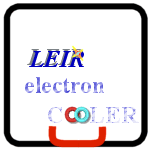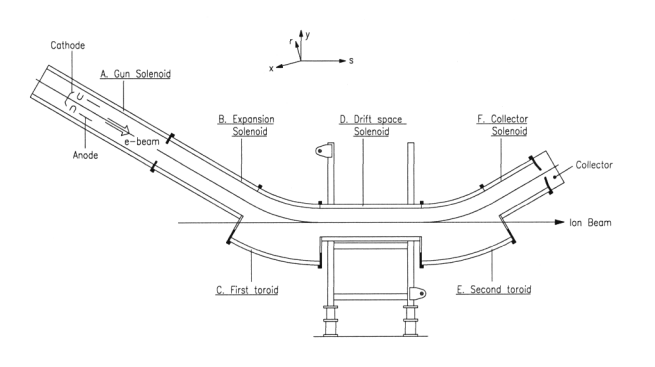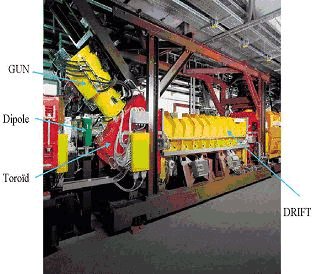 |
 |
 |
 |
| Virginia Prieto AB/BDI/BL | Gerard Tranquille AB/BDI/DS | Eva Barbara Holzer AB/BDI/DS |
IntroductionThe cooling tests in 1997 [1] have shown that it is possible to cool a beam of Dp/p=4% and emittances of more than 50 p mm mrad in less than 400 ms with a 3m long electron cooler providing a 100 mA electron beam with a transverse temperature of 150 meV. The electron cooling device used for these tests has now been installed on the AD and hence a new device has to be built for LEIR. The objective is to cool the ion beam as fast as possible (0.2 s and even faster) by using all the modern features of an electron cooler.The electron cooler deviceThe device we plan to build is similar to devices that are presently in use in many worldwide laboratories and also at CERN on the AD machine. The principle is shown in the figure below.
 Special features of the LEIR coolerTaking into account recent improvements tested on various electron coolers during the last decade, we foresee using a high perveance gun followed by an adiabatic expansion provided by an additional solenoid. The high perveance aims at providing an electron beam with a high density in order to decrease the cooling rate. However, increasing the electron density induces first an increase of the recombination rate, which is detrimental to the ion beam lifetime [1], and secondly increases the electron azimuthal drift velocity thus increasing the cooling time. A compromise must be found.The principles of a high perveance (6 µP) gun are given in [4]. Details of a possible gun for LEIR based on [4] are given in reference [5] where it is shown that to obtain such densities it is mandatory to use a convex cathode embedded in a magnetic field of the order of 0.6 T. More standard gun designs using planar cathodes could also be considered (at GSI [2] they use a gun of 3 µP which could fulfil our requirements), as well as recent ideas for obtaining electron beams with variable density distributions (less electron density in the centre of the electron beam), also using a magnetic field of the order of 0.6 T [6]. The latter is interesting in that the lifetime of the cooled ion beam could be increased by a better control of the recombination of the ions with the electron beam. This is particularly true for the centre of the electron beam where the ion stack sits. With a magnetic field of 0.6 T the induced kick on the ion trajectory, at the level of the toroid, would be difficult to compensate. This is the reason why we foresee a dedicated solenoid aimed at providing an adiabatic magnetic field decrease, by a factor k, between the gun and the toroid. As a consequence, the electron beam radius at the cathode “rc” will be multiplied by k1/2 at the end of the adiabatic solenoid. With such an expansion, the cooling force is optimized as the electron beam size is adapted to the dimensions of the ion beam. The magnetic fieldThe magnetic field B must be uniform in order to insure a good cooling efficiency. Accurate measurements have to be done in order to fulfill the required parameters detailed in reference [7]. Independently of the of the gun requirements, a high magnetic field is welcome for improving the cooling process. On the other hand as mentioned before the vertical component of the magnetic field in the toroids induces an horizontal kick on the ion beam. We therefore foresee a maximum field of 0.1T in the toroids and the drift space. The transverse component B^ must be kept very small so that the ratio B^/B never exceeds 10-4 all along the electron trajectory. This implies the implementation of corrections coils after magnetic measurements. Some emphasis has to be put on the adiabatic solenoid and on the toroids which might induce an unacceptable transverse magnetic field component and therefore increase the electron transverse temperature.The collectorAn efficient collector in mandatory in order to obtain very small electron losses and therefore a small vacuum pressure increase. The present device [8] making use of a repeller, a collector cup and some extra coils gives acceptable performances on the AD machine. It could be retained for the present project.Beam diagnosticsTo optimize the cooling process, some emphasis has to be put on specific beam monitoring system. We foresee to install:
VacuumThe vacuum in LEIR, as seen by the ions, must be of the order of 10-12 torr. The pressure increase within the cooler results mainly from the electron current losses which must therefore be kept as low as possible thanks to a good collector. The cooler must be made bakeable and constructed according to the CERN criteria for ultra-high vacuum (special steel, vacuum firing..) as given in [9]. It must be equipped with the necessary pumping and measuring systems |